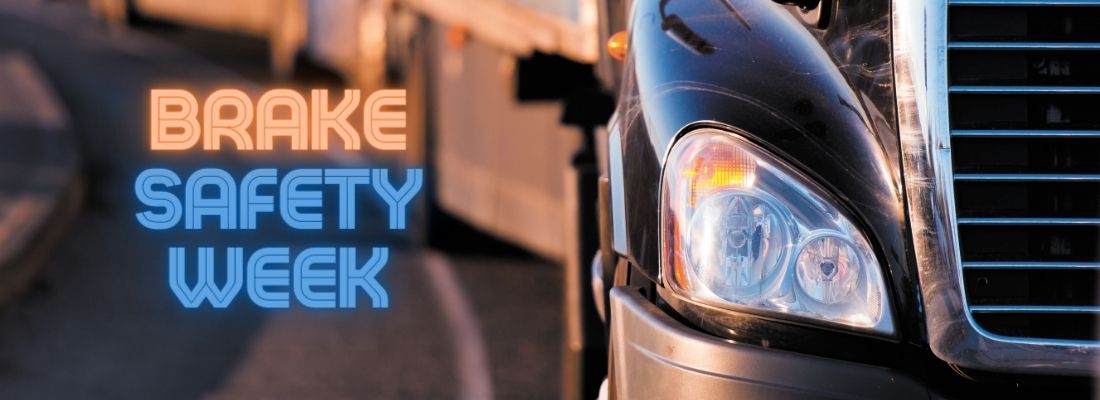Yet brake-related violations remain the top reason for out-of-service vehicles. During the three-day International Roadcheck initiative last May, 38.9% of all vehicle retirements were due to brake system and brake adjustment violations.
This year’s Brake Safety Week will take place August 22-28 throughout North America. Inspectors will pay particular attention to brake hoses and tubing.
Why Brake Safety Week?
Brake Safety Week is an opportunity to highlight the importance of brake systems. Enforcement officers conduct inspections and remove heavy vehicles with brake violations from our roads. It is also an opportunity for carriers to educate their drivers and service providers on the importance of brake system safety.
Sgt. John Samis, with the Delaware State Police and president of the Commercial Vehicle Safety Alliance (CVSA), said, “We chose to focus on brake hoses/tubing this year in an effort to reduce deaths and injuries as a result of commercial motor vehicle brake-system failures from pressure or vacuum loss due to brake hose/tubing deficiencies.”
Brake Safety Week is part of the comprehensive Airbrake program, which aims to reduce the number of traffic accidents caused by defective brake systems on heavy vehicles. This can be achieved by conducting roadside inspections and educating drivers, mechanics, and owner-operators on the importance of brake inspection, maintenance and operation.
Tips for a Successful Week
Use an ELD to facilitate compliance
One of the most effective ways to stay compliant and avoid violations is to conduct a pre-trip inspection, follow hours of service regulations and have all required documentation on hand.
A solution such as ISAAC’s makes it easy to follow this advice. The smart pre-trip inspection includes all inspection points directly in the electronic logging device (ELD). This ensures that nothing is missed. It also eliminates the need to search for the paper list that always gets lost in the permit book! The smart pre-trip inspection assists drivers and serves as a reminder.
The electronic logbook automatically updates the hours of service according to the activities performed by the driver. Thus, each activity is associated with the right service status and allows to follow in real time the remaining driving hours to avoid violations.
Finally, an ELD allows to keep all the documents that need to be on board the vehicle in an electronic library. This makes the documents easily accessible and makes the roadside inspection a hassle-free event.
Perform a thorough inspection
When inspecting your brake system components, make sure that the brake hoses and tubing are:
- Securely attached
- Not damaged
- Free of leaks
- Flexible
Know how to recognize worn or chafed tubing. Remember, roadside enforcement inspectors look for wear and damage to brake hoses and tubing. Here’s a description of the out-of-service (OOS) conditions, along with the U.S. Federal Motor Carrier Safety Regulation number for reference:
- Any damage extending through the outer reinforcement ply. (393.45(a))
NOTE: Rubber impregnated fabric cover is not a reinforcement ply.
NOTE: Thermoplastic nylon tube may have braid reinforcement or color difference between cover and inner tube. Exposure of second color is an out-of-service condition.
- Bulge/swelling when air pressure is applied. (393.45(a))
- Audible air leak at other than a proper connection. (393.45(a))
- Improperly joined such as a splice made by sliding the hose ends over a piece of tubing and clamping the hose to the tube. (393.45(a))
- Damaged by heat, broken, or crimped in such a manner as to restrict air flow. (393.45(a))
Some Statistics
- The brake system is the third most cited factor in fatal commercial and passenger vehicle crashes, according to the Federal Motor Carrier Safety Administration’s (FMCSA) latest Large Truck and Bus Crash Facts report.
- Brake-related violations accounted for eight of the top 20 vehicle violations in 2020, according to FMCSA’s Motor Carrier Management Information System.
- During last year’s Brake Safety Week, 12 percent of 43,565 commercial vehicles inspected were placed out of service for brake-related violations.
Conclusion
Although brake safety is a week-long campaign, your truck’s brake safety is important every day. Put the odds on your side by leveraging the capabilities of telematics to keep your trucks safe and compliant.

